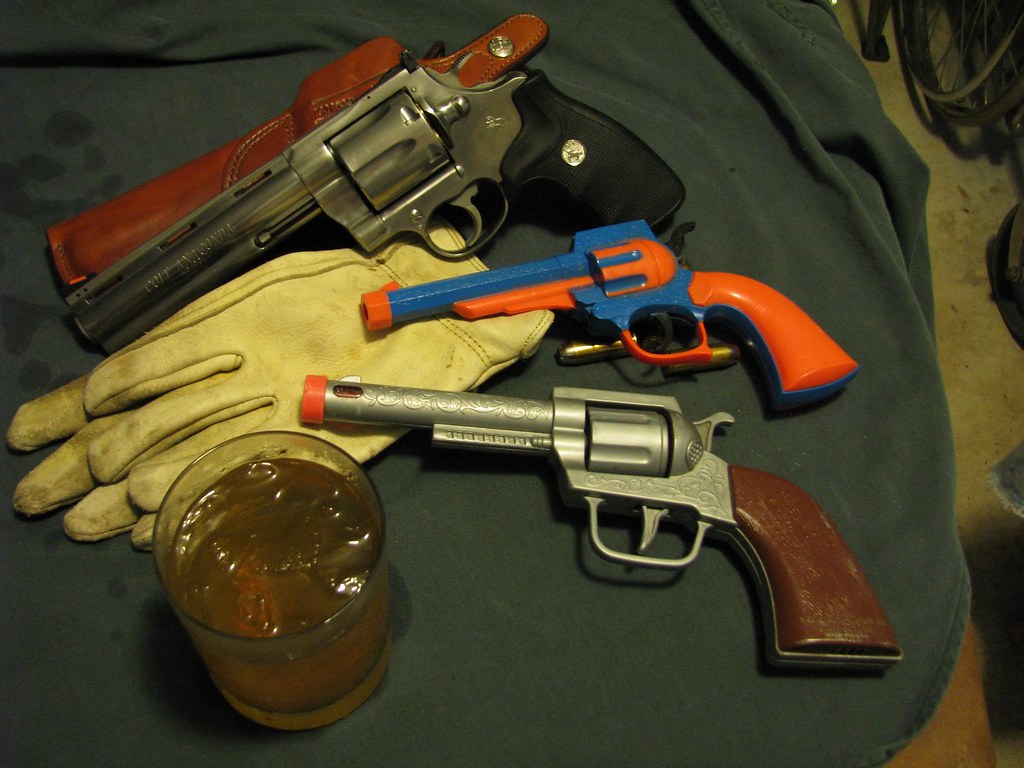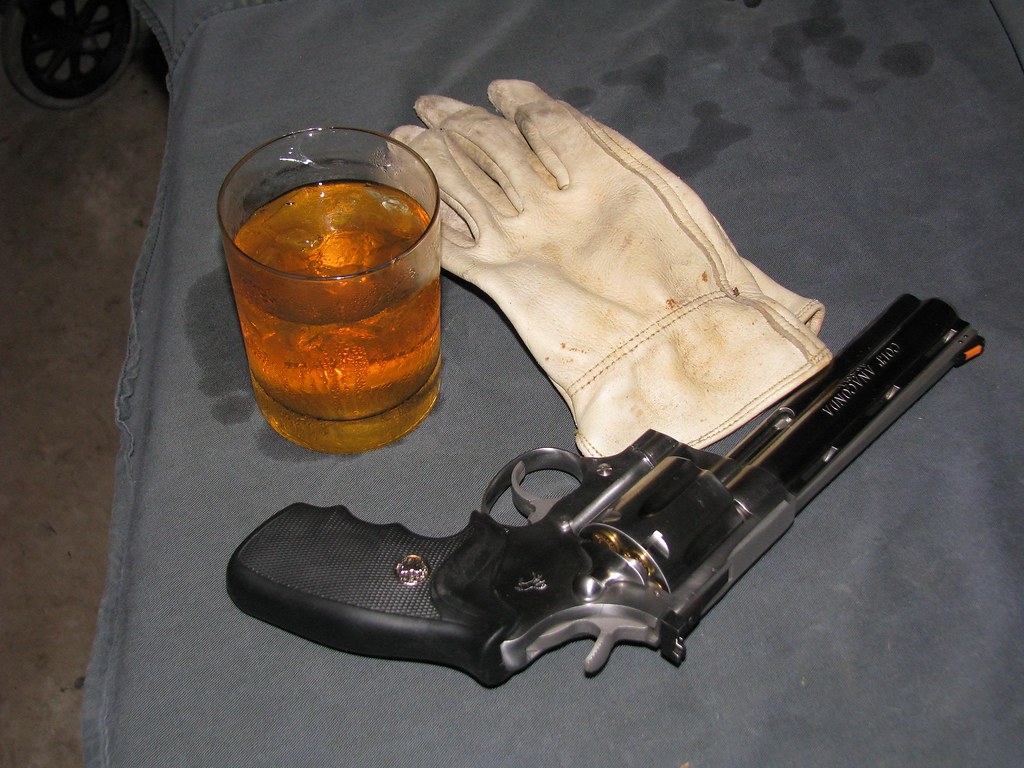More contrast with the drink.
Ashtray is not on top of the gloves.
This is The Lovely Harvey's simpler version. It's a lot more spontaneous than the one I took.
Comments:
27th-May-2009 02:22 pm (local)
Very nice. I greatly approve of the improved contrast.
I think you could do with a broader Depth of Field, which (since you don't seem to have manual control of your aperture) probably means More Light, or a higher ISO setting. I also think your framing is a little tight in this one. Both the glass and the ashtray are clipped by the edge of the frame. The revolver is missing the nice broad highlight that was present in your first attempt, and I think you shot at a higher angle. The backdrop is working well, nice texture and good contrast with the glass. I especially like the little wrinkles near the corners, though I'd try to avoid the dark drip spots (from condensation?). The ammunition, too, is a great addition. In fact, I think it gives the shot that extra something I was missing. -- Now, to bring all the elements together and get the perfect shot... With the good backdrop and the broad highlights (and maybe simply more light?). With the ammunition and perhaps a lower angle and/or slightly wider framing. And absent the drip spots. I really think you're doing very well, and you're getting close to producing something that deserves a frame. | ||
29th-May-2009 10:44 am (local)
I might have control of my aperture. What does Canon call it in their menu? Is that the f stop or exposure? I know I have exposure control. ISO is tweeky with this camera, I really need a tripod to experiment with it, that way I can have the exact same angle every time.
My backdrop for contrast was smaller, so I needed to get tighter to hide the edges. Also, Webshots seems to have clipped it slightly, how thoughtful of them! The higher angle is from the "hide the edges of the backdrop". I have acquired an Army blanket that will allow for a lower angle and a little less tight. The ammo is a joke, the gun is still loaded. | ||
29th-May-2009 11:57 am (local)
f-stop is a measurement of the size of the aperture.
In general, the smaller the aperture, the broader the Depth of Field (the greater the front-to-back depth area of the image that will appear to be "in focus"). Conversely, the larger the aperture, the shorter the depth of field. With a really large aperture, you'll notice that only things very near the point you focused on are in focus. Stuff much closer or farther away will be blurry. With a tiny aperture, pretty much the whole depth of the image will be in focus, assuming you focused on something near the middle of that depth. Make sense? Good. It's too bad they numbered F-stops backwards. A larger number is a smaller aperture, and vice versa. So f/1.8 is a huge aperture, letting in lots of light but reducing the depth of field to paper thickness. And f/16 is a tiny aperture, greatly reducing the light reaching the sensor, but producing a much broader DOF. This tradeoff is valuable in different sorts of photography. For instance, for a portrait where you want the viewer's attention focused firmly on the subject, you'll commonly use a very large aperture, between f/2 and f/3.2 and position the subject some distance away from the background. This yields a photo where the subject is sharply in focus, but the background is blurred, another factor coercing the viewer's attention onto the subject. And in relatively small-scale still-life shots (such as this) you'll generally want to use about the smallest aperture available, so that as much depth in the shot as possible is in focus. This "second attempt" shot is close. But you can see that the nearest end of the cigar is clearly not sharp. Most consumer lenses start to suffer from diffraction and other image degrading issues at apertures smaller than about f/16. So f/16 is what my target aperture would be for this shot. Obviously, f/16 is not going to let in a lot of light. Which means you'll need to compensate in one of a limited number of ways. First, you could add more light. More, brighter light reflecting off the subject gets more into the camera. Second, you could use a longer exposure time. Leaving the shutter open for two or three or seven seconds will dramatically increase the amount of light that reaches the sensor. Be careful though, at shutter times less than about 1/60th of a second, camera motion (if shooting hand held) will become noticeable, blurring your subject and countering any advantage you might have gotten from using a smaller aperture. Obviously, on a tripod or well braced you can start to use much longer shutter times, since you have such a nice stationary subject. Also, longer lenses and longer focal lengths will show more camera motion. A good rule of thumb is not to hand-hold shots with shutter speed slower than 1/focal-length. For example, I have a 70mm-300mm zoom lens. When I'm all the way "wide" I could try holding shots at about 1/100s of a second. When I'm zoomed all the way in, I find 1/300s is ok if I'm well braced, but I try to shoot at 1/500 or faster... Which gets difficult, because the lens is collecting less light with a narrower field of view. Long lenses are best used in brightly lit circumstances. Third, you could turn up the ISO sensitivity of your camera. This increases the sensitivity of the sensor to light. In geek speak, it reduces the threshold that the receptor cell needs in order to turn its pixel on. Which makes it more sensitive to lower levels of light. But it also increases the noise level. Which is why for professional photography you'll see people always using the lowest ISO setting the camera supports. (ISO 100 is a standard). But for casual or recreational photos, you probably won't notice the difference until up around ISO 800. Unfortunately, this is one of those things that varies somewhat by camera manufacturer and quality. | ||
29th-May-2009 12:14 pm (local)
Aperture has a surprisingly large affect on the impact of the resulting image. I've taken to leaving my camera in "aperture priority mode" (The little "A" next to the word "Auto" and the "M" for full Manual).
So with the camera in Aperture Priority I dial it to the aperture I want to use for the shot, and the camera will set the other settings pretty much as though it were in "auto". Handy for quickly setting up the shot I want under varying conditions. For me, light quality direction and hardness are the first most important factor. Obviously you want an interesting subject, and you want it to be well focused and exposed. But very next on the list is Depth of Field. A portrait shot (with a 50mm lens and about 6-10 feet from the subject) at f/1.8, the person's eyes will be in focus, but their nose may not be, and their ears will be blurry. Shot at f/3, all of their head should be in focus, and all of the background should be noticeably blurred. At f/8, depending on the distance between the subject and background, much of the background will probably be in focus as well. At f/16, pretty much everything in the frame will appear sharp. Some of this has to do with the subject's distance from the camera, too. Focused at 100 yards, the DOF of f/1.8 might be a few feet, and f/16 is the whole world. Focused at two feet from the camera, f/1.8 will be paper thin, and f/16 will just about cover the table top. This is one of the ways that our brains have learned to detect "model photography" in movies. The aperture of the camera is MUCH LARGER in comparison to the subject and apparent distance than it would be if the camera were in scale with the models. And accordingly, the depth of field appears abnormally narrow. Interestingly, this effect can be faked in software, making an image of reality appear to our pre-trained brains to be an image of a model. http://theopenend.com/2009/02/09/wo http://www.smashingmagazine.com/200 |






No comments:
Post a Comment
You are a guest here when you comment. This is my soapbox, not yours. Be polite. Inappropriate comments will be deleted without mention. Amnesty period is expired.
Do not go off on a tangent, stay with the topic of the post. If I can't tell what your point is in the first couple of sentences I'm flushing it.
If you're trying to comment anonymously: You can't. Log into your Google account.
If you can't comprehend this, don't comment; because I'm going to moderate and mock you for wasting your time.